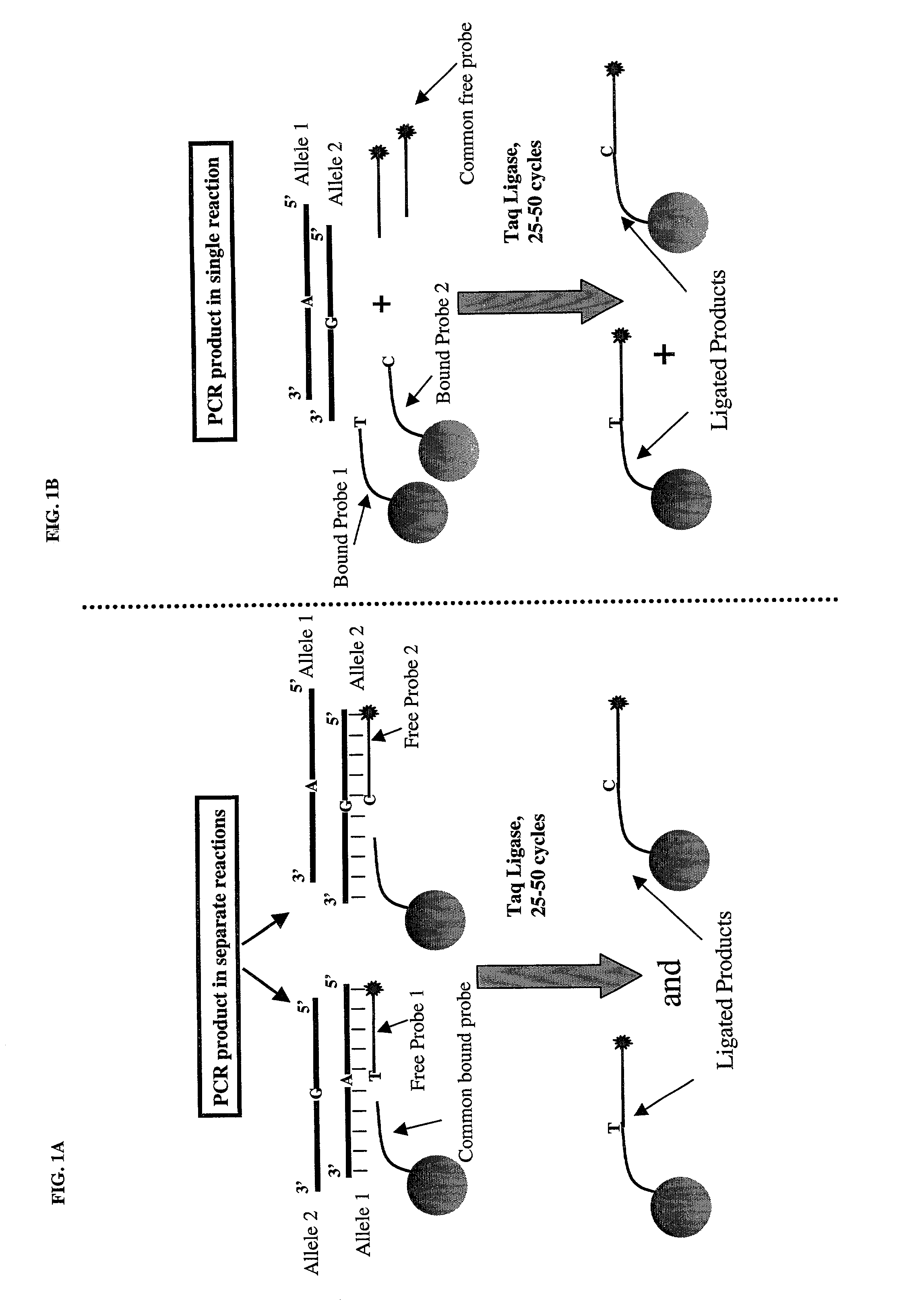Microsphere based oligonucleotide ligation assays, kits, and methods of use, including high-throughput genotyping
- Summary
- Abstract
- Description
- Claims
- Application Information
AI Technical Summary
Benefits of technology
Problems solved by technology
Method used
Image
Examples
embodiment 1
[0040] FIG. 1 depicts a schematic diagram of two of the embodiments using OLA coupled to spectrally addressable microsphere technology. The PCR amplified target used in this example represents a target that is heterozygous for an SNP (shown as Allele 1 & 2). Embodiment 1 is depicted in FIG. 1A. In FIG. 1A, the probe that is coupled to the microspheres via its 5' end is common to both alleles, and the 3' end of this probe stops short of the polymorphic nucleotide. The two free probes (shown as Free Probe 1 & 2) have the appropriate bases complementary to the target's polymorphic bases at their 5' ends and biotin modification at their 3' ends (shown as stars). In addition, the 5' ends of the free probes are phosphorylated, as required for an enzymatic ligation reaction. The biotin molecule at the 3' end serves as a reporter for monitoring the success of the ligation reaction. Also, since a single reporter or detectable label is used for detection, the free probes should be used in sep...
example 1
6. Example 1
[0044] In this example, two different genomic DNA samples were used to generate 242-bp PCR amplicons from HLA-DQA1 loci that harbored a G / C SNP. One sample was heterozygous for the SNP while the other was homozygous for the C allele. Using these two samples, both Embodiments were analyzed for factors that affect the efficiency of the microsphere-based OLA genotyping. Optimization results are shown in FIG. 2 to FIG. 5, and described below.
[0045] 6.1 PCR Amplification of Targets
[0046] Targets for OLA comprising 242 bp fragment from the HLA class II DQA1 locus. PCR amplification was performed using primers DQA-A (5'GTGGTGTAAACTTGTACCAGT 3') and DQA-B (5'TTGGTAGCAGCGGTAGAGTTG3'). Typical amplification reactions included I micromolar of each primer, 200 micromolar of each nucleotide (dNTPs), reaction buffer (Quiagen, Valencia, Calif.), Thermostable Polymerase (2.5 units) (Quiagen, Valencia, Calif.) and 100 ng genomic DNA as template in a 50 microliter reaction. Each reaction ...
embodiment 2
[0060] 6.5 Embodiment 2
[0061] In this embodiment, the two allele-specific probes were coupled to 2 spectrally distinct bead sets and had the following sequences:
2 DQ3401 Bound-5'UnilinkATGAATTTGATGGAGATGAGG-3' DQ3402 Bound-5'UnilinkATGAATTTGATGGAGATGAGC-3' DQ340X Free-5'-pAGTTCTACGTGGACCTGGA-3'Biotin
[0062] Here, the free probe, DQ340X, was common to both alleles, while DQ3401 corresponds to Allele 1, and DQ3402 corresponds to Allele 2. P also indicates a phosphate modification. In this embodiment, all the reagents for the discrimination between the two alleles were placed in a single reaction vessel since the allele-specific probes were coupled to spectrally distinguishable beads. The components of the reaction mixture were as follows: 5000 beads coupled to each one of the two allele-specific probes (total 10000 beads), reaction buffer (supplied by vendor), 5-20 ng of PCR amplified DNA as template, Thermostable Ligase (5-10 units) and 200 nanomolar free probe. All reagents are prese...
PUM
| Property | Measurement | Unit |
|---|---|---|
| Concentration | aaaaa | aaaaa |
| Acidity | aaaaa | aaaaa |
| Nucleic acid sequence | aaaaa | aaaaa |
Abstract
Description
Claims
Application Information
 Login to View More
Login to View More - R&D
- Intellectual Property
- Life Sciences
- Materials
- Tech Scout
- Unparalleled Data Quality
- Higher Quality Content
- 60% Fewer Hallucinations
Browse by: Latest US Patents, China's latest patents, Technical Efficacy Thesaurus, Application Domain, Technology Topic, Popular Technical Reports.
© 2025 PatSnap. All rights reserved.Legal|Privacy policy|Modern Slavery Act Transparency Statement|Sitemap|About US| Contact US: help@patsnap.com



